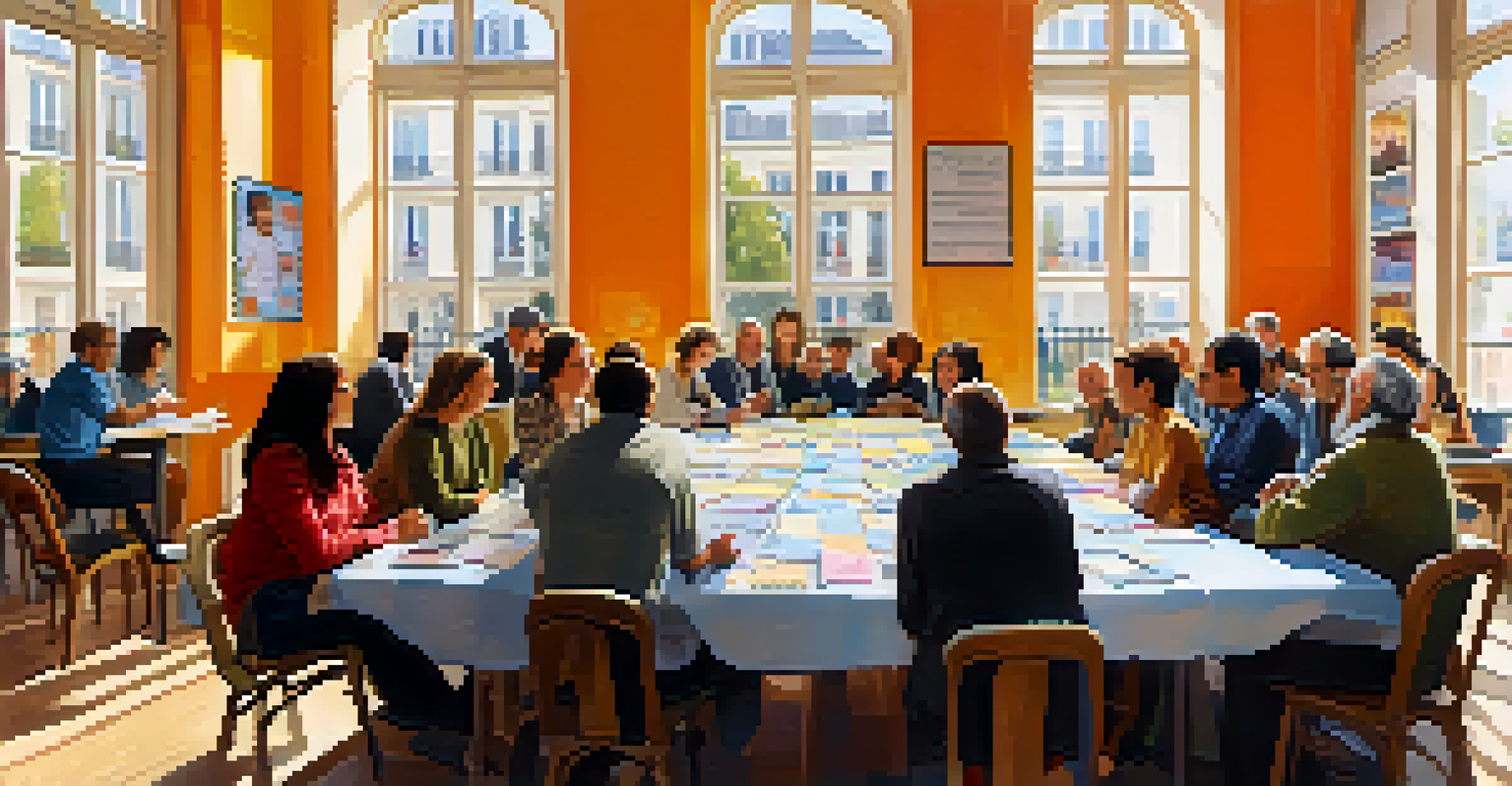Case Studies: Successful Public Engagement in Urban Projects

Understanding Public Engagement in Urban Development
Public engagement in urban projects refers to the processes that involve community members in decision-making. This approach moves beyond traditional top-down methods, fostering a sense of ownership among residents. When communities actively participate, they contribute valuable insights that can shape more effective and inclusive projects.
The best way to predict the future is to create it.
Imagine a community garden project where local residents help design the layout and choose the plants. This not only results in a garden that reflects the community’s needs but also builds camaraderie and commitment among participants. By understanding the dynamics of public engagement, urban planners can create spaces that truly resonate with the community.
Ultimately, effective public engagement can lead to stronger support for urban initiatives, as residents feel their voices are heard and valued. This sets the stage for successful implementation and maintenance of urban projects, reinforcing the importance of collaborative efforts.
Case Study: The High Line in New York City
The High Line, an elevated linear park built on a former railway, serves as a prime example of successful public engagement. Originally envisioned by a community group, the project gathered momentum through extensive public input and grassroots lobbying. This collaboration not only transformed a neglected space but also ignited a movement for urban revitalization in New York City.

What started as a dilapidated structure is now a vibrant space filled with art, gardens, and stunning views of the city. The High Line’s success lies in its ability to involve diverse stakeholders, from local residents to city officials, in the design and planning process. This collective ownership has resulted in a beloved landmark that continues to thrive.
Community Involvement is Crucial
Engaging residents in urban projects fosters a sense of ownership and leads to more effective and inclusive outcomes.
Moreover, the High Line has demonstrated the economic benefits of public engagement, boosting local businesses and tourism. It serves as a model for future urban projects, showing how community involvement can lead to sustainable urban environments that cater to the needs and desires of the population.
Case Study: Participatory Budgeting in Paris
Participatory budgeting in Paris is another noteworthy example of public engagement in urban projects. This initiative allows residents to propose and vote on specific projects funded by a portion of the city’s budget. By empowering citizens to take an active role in fiscal decisions, the city fosters transparency and inclusivity.
Community engagement is a process that builds trust and a sense of ownership among residents, leading to more effective urban development.
Imagine a community where residents can decide to allocate funds for new playgrounds, bike lanes, or public art installations. This not only enhances civic pride but also ensures that investments align with the community’s priorities. The participatory budgeting process has led to significant improvements in various neighborhoods, reflecting the will of the people.
As a result, Paris has seen increased trust between citizens and local government. Such initiatives demonstrate the power of engaging the public in financial decisions, ultimately leading to a more responsive and accountable urban governance model.
Case Study: Community-Led Urban Regeneration in Glasgow
In Glasgow, community-led urban regeneration projects have redefined the relationship between residents and their environment. One notable initiative involved local residents collaborating with urban planners to revitalize a neglected neighborhood. This grassroots approach not only restored physical spaces but also rejuvenated community spirit.
When residents took the lead, they brought unique perspectives that traditional planners might overlook. For example, they advocated for green spaces, local markets, and accessible public transport, ensuring that the regenerated area met their needs and aspirations. This project transformed the neighborhood into a vibrant hub, attracting new residents and businesses.
Examples of Successful Engagement
Case studies like the High Line and participatory budgeting in Paris showcase how public input can transform urban spaces.
The success of this approach highlights the importance of local knowledge in urban planning. By prioritizing community engagement, cities like Glasgow can create spaces that are not only aesthetically pleasing but also functional and welcoming for all.
Lessons Learned from Successful Urban Engagement Projects
Analyzing successful urban engagement projects reveals key lessons that can be applied to future initiatives. First and foremost, genuine outreach and communication are crucial. It’s not enough to simply inform the public; planners must actively listen and adapt to community feedback, fostering a two-way dialogue.
Additionally, diversity in participation is essential. Engaging various demographics ensures that all voices are represented, leading to more equitable outcomes. For instance, involving marginalized groups can uncover issues that might otherwise be neglected, enriching the planning process.
Finally, establishing trust and relationships with the community lays the groundwork for sustainable engagement. When residents feel respected and valued, they are more likely to participate in future initiatives, contributing to a cycle of ongoing collaboration and improvement.
The Role of Technology in Public Engagement
In today’s digital age, technology plays a pivotal role in enhancing public engagement in urban projects. Online platforms facilitate broader participation by allowing residents to share ideas, vote on proposals, and provide feedback from the comfort of their homes. This accessibility can lead to a more inclusive planning process.
For instance, virtual town halls and social media campaigns can reach diverse audiences, especially those who may not attend in-person meetings. Technology can also streamline the collection and analysis of community input, enabling planners to respond more quickly to public needs and preferences.
Technology Enhances Participation
Digital tools facilitate broader public engagement, making it easier for diverse community members to contribute to urban planning.
However, it’s essential to ensure that these digital tools do not alienate those without internet access. Balancing traditional and digital engagement methods can help create a more equitable approach, ensuring that all community members have a voice in shaping their urban environments.
Future Directions for Urban Public Engagement
As cities continue to evolve, the importance of effective public engagement in urban projects will only grow. Future initiatives should focus on creating adaptable frameworks that can respond to changing community needs and preferences. This flexibility will allow urban planners to better address emerging challenges, such as climate change and population growth.
Moreover, fostering long-term relationships with community members will be vital in building a culture of engagement. By continuously involving residents in the planning process, cities can develop a sense of shared responsibility and stewardship, ensuring that urban spaces are maintained and respected.

Ultimately, the future of urban public engagement lies in collaboration, innovation, and inclusivity. By prioritizing these principles, cities can create vibrant, resilient communities that thrive through active participation and shared vision.